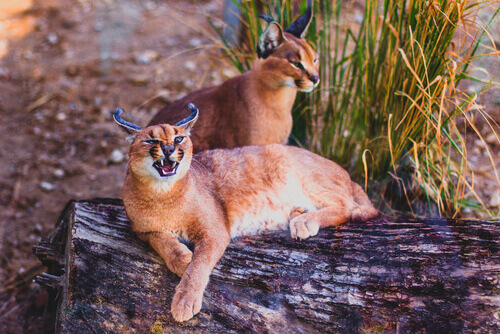All About the Caracal: Characteristics, Feeding and Habitat

The caracal was always thought to be a close relative of the lynx. However, scientists have recently discovered that other cats are closer relatives of this desert feline.
Characteristics of the caracal
The caracal is a medium-sized feline that has perfectly adapted to the conditions of its habitat: the desert. As regards its physical appearance, its fur is a tawny reddish color and uniform, without stripes or spots. As a result, it’s better camouflaged against the color of the sandy soil.
Although it may seem that all caracals are the same color, in reality this varies depending on the area. To camouflage itself against the soil, the fur can be lighter or darker. For example, caracals with much redder fur have been seen in areas where the ground is darker or earthier.
However, their most notable physical characteristic are the ‘brushes’ on their ears, similar to those of the lynx. At the tip of each ear. they have a few stiff black hairs that help them camouflage themselves. Their faces have white patches for this same purpose.
In terms of size, both males and females are about three feet long, not counting the tail. Males weigh between 22 and 45 pounds, while females are slightly lighter, weighing between 18 and 33 pounds as adults. Their tails are relatively short, measuring only 12 inches long.

Scientists thought the caracal was related to the lynx, but the latest DNA studies say this isn’t the case. Actually, the caracal is genetically closer to the serval, another African cat. In fact, in captivity these two species can interbreed.
Feeding
The caracal is a carnivorous feline that feeds on the animals it hunts – small mammals such as rabbits, hares or mice. In some areas of Africa, it even chases and hunts antelope calves.
This feline is a very fast and agile hunter, and its favorite prey are birds. The caracal usually stalks them when they’re on the ground, jumps on them by surprise and kills them with one bite. However, if the birds take flight, the caracal can make a spectacular leap of up to ten feet to catch them.
Farmers often complain about these animals entering pens and carrying off chickens; they can even climb trees to catch nesting birds. They don’t only catch small birds – they sometimes even hunt eagles.
Caracal habitat
The caracal’s habitat is vast: they live throughout most of Africa, the Arabian Peninsula, and into Asia as far as India. However, the health of their populations varies depending on where they live.

There aren’t many in North and West Africa, but in the rest of the continent their numbers are healthy and they’re not considered to be endangered. In the Arabian Peninsula, there are also large populations of this animal, although in Turkey there are hardly any left.
In Iran, the species is becoming endangered due to habitat destruction, and, in India, there are very few left and their numbers will continue to decrease little by little.
All these places seem very different from each other, but the caracal is able to adapt to all of them. In general, they’re sandy regions, although there are different living conditions. This cat lives in the savannah, in the mountains, in areas with a lot of scrub, and in semi-desert climates. It avoids living in jungles, meaning that there aren’t many in central and western Africa.
To recap, the caracal is a feline that lives in Africa and Asia. It was thought to be related to the lynx, but it’s closer to servals. In some regions it’s threatened, in others it’s still OK. The fact that it’s not on the endangered list is good news for everyone.
The caracal was always thought to be a close relative of the lynx. However, scientists have recently discovered that other cats are closer relatives of this desert feline.
Characteristics of the caracal
The caracal is a medium-sized feline that has perfectly adapted to the conditions of its habitat: the desert. As regards its physical appearance, its fur is a tawny reddish color and uniform, without stripes or spots. As a result, it’s better camouflaged against the color of the sandy soil.
Although it may seem that all caracals are the same color, in reality this varies depending on the area. To camouflage itself against the soil, the fur can be lighter or darker. For example, caracals with much redder fur have been seen in areas where the ground is darker or earthier.
However, their most notable physical characteristic are the ‘brushes’ on their ears, similar to those of the lynx. At the tip of each ear. they have a few stiff black hairs that help them camouflage themselves. Their faces have white patches for this same purpose.
In terms of size, both males and females are about three feet long, not counting the tail. Males weigh between 22 and 45 pounds, while females are slightly lighter, weighing between 18 and 33 pounds as adults. Their tails are relatively short, measuring only 12 inches long.

Scientists thought the caracal was related to the lynx, but the latest DNA studies say this isn’t the case. Actually, the caracal is genetically closer to the serval, another African cat. In fact, in captivity these two species can interbreed.
Feeding
The caracal is a carnivorous feline that feeds on the animals it hunts – small mammals such as rabbits, hares or mice. In some areas of Africa, it even chases and hunts antelope calves.
This feline is a very fast and agile hunter, and its favorite prey are birds. The caracal usually stalks them when they’re on the ground, jumps on them by surprise and kills them with one bite. However, if the birds take flight, the caracal can make a spectacular leap of up to ten feet to catch them.
Farmers often complain about these animals entering pens and carrying off chickens; they can even climb trees to catch nesting birds. They don’t only catch small birds – they sometimes even hunt eagles.
Caracal habitat
The caracal’s habitat is vast: they live throughout most of Africa, the Arabian Peninsula, and into Asia as far as India. However, the health of their populations varies depending on where they live.

There aren’t many in North and West Africa, but in the rest of the continent their numbers are healthy and they’re not considered to be endangered. In the Arabian Peninsula, there are also large populations of this animal, although in Turkey there are hardly any left.
In Iran, the species is becoming endangered due to habitat destruction, and, in India, there are very few left and their numbers will continue to decrease little by little.
All these places seem very different from each other, but the caracal is able to adapt to all of them. In general, they’re sandy regions, although there are different living conditions. This cat lives in the savannah, in the mountains, in areas with a lot of scrub, and in semi-desert climates. It avoids living in jungles, meaning that there aren’t many in central and western Africa.
To recap, the caracal is a feline that lives in Africa and Asia. It was thought to be related to the lynx, but it’s closer to servals. In some regions it’s threatened, in others it’s still OK. The fact that it’s not on the endangered list is good news for everyone.
This text is provided for informational purposes only and does not replace consultation with a professional. If in doubt, consult your specialist.








